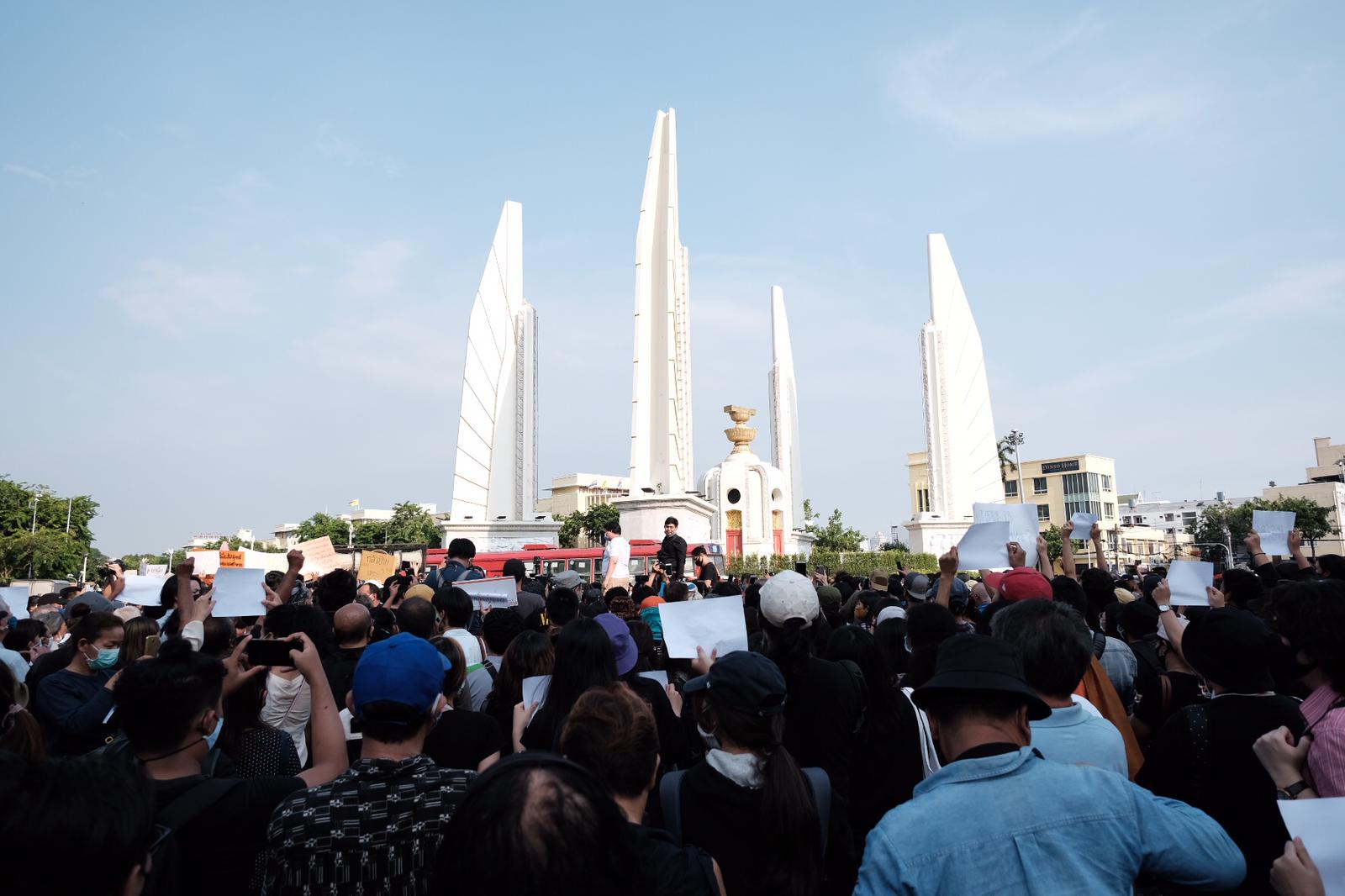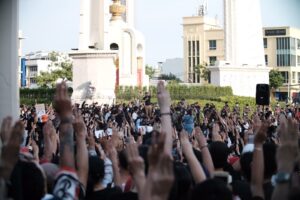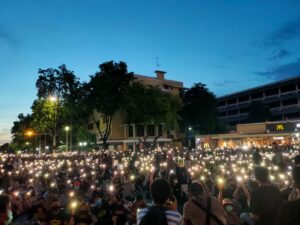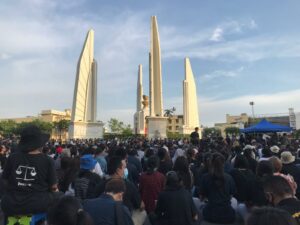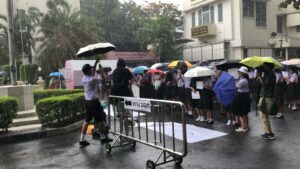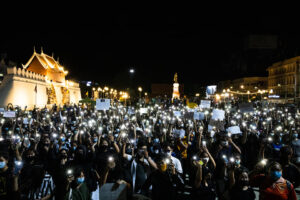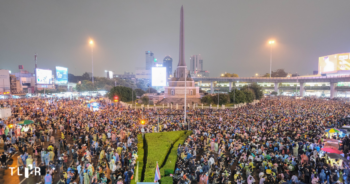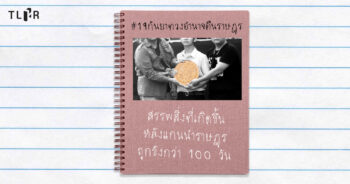On 18 July 2020, a group of secondary school and university students, together with other ordinary citizens, held the #FreeYouth demonstration at the Democracy Monument. The protestors’ three collective demands call for the government to dissolve the Parliament, rewrite the Constitution, and end all forms of state harassment of critics. During the following two weeks, this event has triggered a wave of flash mob rallies in other areas across the country to reiterate the three demands until now.
According to the information gathered by Thai Lawyers for Human Rights (TLHR), there have been at least 75 announcements about plans to organize a protest and public activity in 44 provinces across the country to support the Free Youth group’s demands. In many other places, protestors have vowed to hold their events until mid-August.
It is interesting to note that a large proportion of protestors belong to the young generation of Thai people. In several areas, secondary school students organized and led the protests. Moreover, the protestors designed their activities with great creativity and diversity to communicate their demands to the public and the government.
However, the rise of protests and political expressions in public has prompted interventions from state officials who tracked down, harassed, and suppressed protest leaders and participants in many places. Out of at least 76 planned activities, five could not be organized – including one activity in Sakon Nakhon province where a protest was postponed because the organizers were not ready. In this case, the authorities also reportedly met and had a discussion with the administration of a local university where the protest was set to take place.
Apart from pressuring and intimidating organizers to stop their activities, TLHR has observed at least eight general trends of harassment:
1. Before activities began, state officials in some areas- including the police, Special Branch officers, and administrative officers- had tracked down some secondary school and university students and ordinary people to their houses or personal spaces. They claimed that they needed to gather information to report to their superiors or wanted to understand more about the upcoming activities.
If state officials could identify the organizers, they would directly visit them at houses to inquire about the activities’ details and record the organizers’ personal information. Meanwhile, if they were unable to identify the organizers, they would reach out to different groups of people who had previously engaged in activism or participated in a flash mob rally earlier at the beginning of 2020. Remarkably, these students or people might not have been involved in any way in this new wave of political activities.
The authorities also reportedly tracked down and sought to identify people who advertised the protest activities via social media platforms or make inquiries about such activities in social media groups. This type of operation brought up questions from the victims of harassments who wondered under which law the authorities were invoking their powers. In several cases, the officials did not mention which specific legal provision they were invoking to operate whereas, some operations were blatantly unlawful.
Overall, state operations are often carried out in the forms of warning, suppressing, and intimidating protest organizers, participants, and other related parties who could influence the organizers’ decision. The goals were to terminate public assemblies or pose limits upon the conditions of organizing them. As most organizers are young people, the officials sometimes decided to approach their parents, asking them to prevent their children from participating in political activities. They would often mention that students must focus on their studies and threaten that their participation in a political movement would adversely impact their studies. Due to such harassment, some protests had to be canceled or subject to a change of organizers. (See an example of the rally in Lampoon Province).
2. In addition to visiting houses, some plainclothes officers reportedly threatened to take some protest organizers to a police station without an official warrant. They claimed that they merely wanted to inquire about the organizers about their activities. One police superintendent stated that the police regularly conduct this process to gather intelligence. However, TLHR later found that the police officers took the organizers to the station to persuade and pressure them to back away from the protest. Both working-level and high-level officers in the same area were involved in this operation. (See a case study in Petchabun province)
3. During almost every event, state officials put up posters, handed out pamphlets, or made announcements using an amplifier to threaten the protestors that their activities might constitute a violation of the law. They make references to several legislations, especially the Emergency Decree’s provisions on the prohibition of public assembly or gathering for unlawful purposes, which might pose risks of spreading diseases. Other laws mentioned during such announcements included the Communicable Diseases Act, the Road Traffic Act’s provisions on the obstruction of traffic, the Controlling Public Advertisement by Sound Amplifier Act, and the Act on the Maintenance of the Cleanliness and Orderliness of the Country.
The announcements of legal prohibitions were found to be a nuisance in some cases because they were carried out while the protestors were delivering speeches to express their opinions and presenting their collective demands. Some frustrated protestors had to approach the police officers and ask them to turn down the volume or stop making the announcements.
4. Similar to past trends, officers in plainclothes and uniforms continued to take photos of the demonstrations. However, TLHR found that several officers aimed to target specific individuals during these recent flash mob rallies and tended to take pictures of those holding protest signs closely so that they could identify the persons later.
The authorities attempted to obstruct protestors in some provinces from using their intended venues by blocking them from those areas and causing them to move their activities elsewhere. Furthermore, it was reported that military officers and officials from the Internal Security Operations Command in some provinces attended the protests to observe and record the activities.
5. The authorities have weaponized the law by filing charges against protest organizers or participants who delivered speeches, creating additional burdens and complications in their lives. Four university students who gave speeches during the #ChiangMaiWillNotTakeThisAnyMoreToo activity, which took place after the #FreeYouth demonstration, were summonsed to Chiang Mai Provincial Police Station to acknowledge their charges under the Emergency Decree and the Communicable Diseases Act. As illustrated in this case, the Emergency Decree has continued to be used to silence political expressions.
6. The authorities followed some protestors backed to their home, especially those who held up protest signs. They claimed they needed to tell the protestors to stop using these signs because they contained “sensitive” messages, which could be interpreted as critical of the monarchy. Reportedly, they recorded the protestors’ personal information and took their photos.
The authorities had also confiscated the protest signs during the demonstration. In some cases, they arrested the protestors, put their information in an “interrogative record,” and seized the signs, as illustrated during the protest at King Mongkut’s University of Technology North Bangkok. Nonetheless, there is currently no report of any cases instituted or charges filed against any person holding up a protest sign.
The police, Special Branch officers, and administrative officers were not the only ones undermining the protests. As aforementioned, most protestors are secondary school and university students who belong to the younger generation compared to past demonstrations. Therefore, some schools and universities took the lead to undertake measures for suppressing and threatening their students. Several educational institutions prevented the student protestors from using their campus ground as a protest venue and ordered their students to refrain from organizing or participating in a public assembly.
7. The police and Special Branch officers talked to administrators of schools and universities, requesting to obtain the students’ personal information by claiming that they would like to reach a mutual understanding with these student protestors. The authorities had reportedly obtained the information of both the students who had previously participated in a demonstration but did not participate in the recent ones as well as those who participated in the recently advertised ones.
This operation aimed at pressuring students organizing the protests, and discouraging them. Knowing that the authorities already have received their personal information from schools or universities, the students realized they could be further harassed at their own homes. Therefore, they needed to re-assess their risks in organizing the protest as the authorities asserted this kind of pressure via their educational institution in this manner.
8. Schools or universities prohibited their students from participating in any rally. In some areas, after students announced their plan to organize a rally on their campus grounds, their universities issued an order banning them from doing so. This type of ban was issued at Prince of Songkhla University and Mahasarakham University.
In some cases, a director or disciplinary staff of educational institutions summonsed their students to prohibit them from organizing or participating in any protest. As the school authority often claimed that participating in the protest would impact the students’ ability to study or graduate, this tactic triggered fear among them. Reportedly, some teachers also attended the rally to tell their students to stop participating or take photos of the student protestors without any apparent purpose.
The phenomenon of increasing harassment of secondary school and university students hinders their exercise of freedom of expression and assembly, thereby reaffirming and reflecting the significance of the #FreeYouth group’s demand, which calls for government officials to end the harassment. The harassment has taken multiple forms, be it monitoring the students to obtain personal information, tracking them down to homes or schools, triggering fear by telling them that they were on the security agencies’ blacklist, or threatening that the protest would violate the law, such as the Emergency Decree, even before the activities took place.
The attempts to suppress, pressure, and intimidate protestors constitute an attack on peaceful expressions of opinions and unarmed demonstrations, which are the rights enshrined in the 2017 Constitution. Several of these attempts had no legal basis; they merely exploited people’s gaps in knowledge to undermine the power of free expressions.
** Keep in touch with Thai Lawyers for Human Rights to continue receiving updates on the summary of human rights situations and statistical data on the restriction of freedom of expression related to the flash mob demonstrations under the TLHR’s monitoring **
